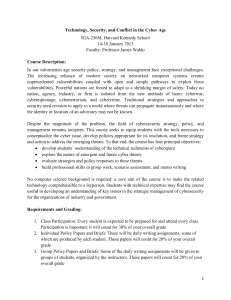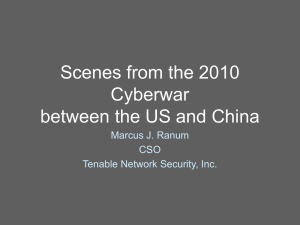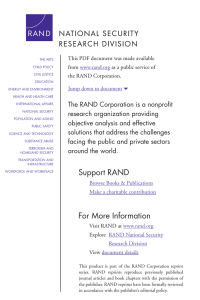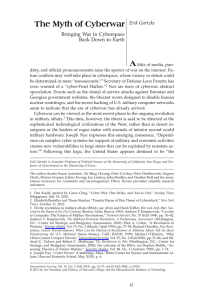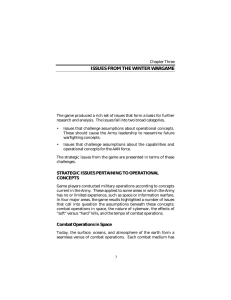Designing and Building a Cyberwar Laboratory and Exercise
advertisement
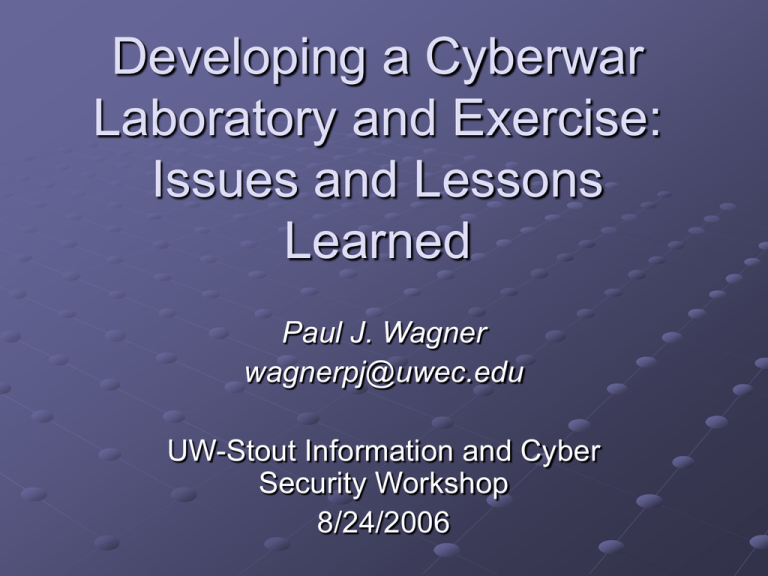
Developing a Cyberwar Laboratory and Exercise: Issues and Lessons Learned Paul J. Wagner wagnerpj@uwec.edu UW-Stout Information and Cyber Security Workshop 8/24/2006 Main Messages Developing a good cyberwar laboratory and related exercise takes: Planning Thought Resources Helps to think about goals and structure Main Messages (cont.) Many issues arise during the development and execution of a cyberwar exercise Consider and work through as many as possible up front A few more will arise in spite of your preparation… Laboratory History Submitted a grant proposal to National Science Foundation (NSF) in late 2002 Course, Curriculum and Laboratory Improvement (CCLI) program Adaptation and Implementation (A&I) sub-program Grant awarded in June 2003 Three parts Develop computer security laboratory Develop two security-related courses Computer Security Cryptography and Network Security Develop course modules for introduction of security issues in other courses Laboratory Goals Mixed use laboratory Not enough space to dedicate to security Need to be able to connect/disconnect from campus network quickly Support both Windows and Linux IUP only supported Linux, real-world environment is heterogenous Be able to emulate a real-world enterprise computing environment Laboratory – Spring 2004 One Way to Lower the Cost Purchase one many-port switch to act as physical switch, all hubs Can isolate groups of ports Can bridge groups where needed Advantages Significant cost savings Reduced maintenance need Disadvantage Initial setup difficult Spring 2005 (and 2006) Version Use of Virtual Machines within Physical Machines Products Microsoft Virtual PC (used 2005) Support discontinued for Mac environment in 8/2006 VMWare (used 2006) Another possibility: Xen Operating systems must be modified Higher performance gained Layout similar to previous diagram, but only one physical machine needed per station Bait machines are also virtual Virtual Machines – Pros/Cons Advantages Easier to generate a heterogeneous network with a limited amount of hardware Able to restore virtual machine on any physical machine in lab Can give student root/administrator privilege on virtual machine Flexibility in a dual-usage environment Damage to a virtual machine is a reduced impact Disadvantages Size of images (e.g. if saving state across semester) Time to compress/save Network bandwidth Ideas for Future VMWare Player, Server are now freely available Virtual network as well as virtual machines Paper on this using UML (another virtualization product) Storage virtual machines on portable storage (e.g. USB drives, iPods) Laboratory – Physical Issues Want to provide some sense of physical security for each station Lab furniture is currently 8 cubicles with high walls Problem: not good for general usage, students tend to “hide” in lab and take over stations Future: a more open physical environment? Exercise Overview Based on exercises attempted and done elsewhere (IUP, US military academies) Reverse version of “capture the flag” => “plant the flag” Final exercise in Computer Security course Exercise Overview (2) Isolated network, consisting of: Student systems “Bait” systems (representing businesses) 8 student teams each given unsecured Windows and Linux systems 24 hours to secure their systems 24 hours to locate other systems and plant a flag on as many other systems as possible Student Preparation Course Computer Security (CS 370) Prerequisite – Data Structures (CS 265) Goals for course Develop understanding and background in: Concepts Tools Ethics Issue: ideally would like students to have some networking background Currently we present this background in course Student Preparation (2) Approach from perspective of security professional Learn as defenders of computer systems and networks Look at what attackers do to understand their mindset and methods Systems approach in an enterprise environment Students sign an agreement that stresses ethical issues and behavior, limits their use of tools to scope of course Student Preparation (3) Weekly Laboratory Exercises Policies Ethics, Social Engineering Information Gathering Tools Packet Sniffing Port Scanning Password Security/Analysis Vulnerability Assessment System Hardening Intrusion Detection The Cyberwar Exercise Goals Real-World Project Team-Based Focus on Defense in a Realistic Environment Defense – understand what needs to be done and how to accomplish it Attack – to experience the mindset and techniques of the attacker Cyberwar Exercise (2) More Goals Gain Experience in: Technological security – with tools used in weekly labs Physical security Social security The Cyberwar Exercise (3) Exercise Structure Pre-lab Set up heterogeneous isolated network Group students into teams Teams work to prepare, schedule coverage Teams discover exact environments (shortly before exercise starts) Cyberwar Exercise (4) Structure (cont.) Defense Period Teams secure systems within constraints of exercise Must keep certain services available; e.g. ssh, mail server Business is a balance between functionality and security Students make entries in online log detailing what defensive techniques they’ve used The Cyberwar Exercise (5) Exercise Structure (cont.) Attack period Teams attempt to plant flag on as many systems on network as possible Defense continues (adjustments, further work) All activities must be added to online log Instructor keeps score based on various criteria Sysadmins attack all student machines at end of period with variety of canned attacks Discussion Whole class discussion after exercise completed Scoring Criteria Positive additions Number of services up at certain checkpoints Successful attacks against other machines Resistance to sysadmin attacks Quality of log entries Negative additions Successful attacks against your machines Rules violations Laboratory Setup for Exercise Goals Heterogeneous and Isolated Network Same system for each student team Replicating tool (e.g. Norton Ghost) saves much time Don’t forget to give each machine its own identity Laboratory Setup (2) Structure of Isolated Network One zone (all systems off one hub) 8 Student Team Systems running older Windows Server, Linux systems Non-current OSs with known security holes All tools used in lab exercises Added several realistic-looking accounts (e.g. backup, logwd, tomcat) with weak passwords Laboratory Setup (3) Structure of Isolated Network (continued) Several Non-Student Systems Other variants of Windows and Linux 1 Monitoring system Additional Available Systems Host systems can be used for internet access Laboratory Setup (4) Outside software transferred only by “sneaker net” Reasoning – no automated updates/patches Students had to understand issues and solutions Major Exercise Issues Which services to require? Too few – not realistic Too many – configuration more complex, difficult to monitor How much physical access? Keyboard access allowed? Problem with student rebooting another system, which hangs waiting for password on BIOS and/or boot loader Exercise Issues (2) Allow Denial of Service (DoS) attacks? Realistic, but … Environment deteriorates Ethics Keyboard issue above Which resources can/should be used? Exercise Experiences Added accounts were a significant hole Valid-sounding account names lower the expectation of risk Non-attended machines were broken into less than the student team machines Successful teams combined multiple exploits Combining weak accounts/cracked passwords with buffer overflow exploit Exercise Experience (2) Social engineering attack showed the power of this method One student team used spoofed email from instructor to request privileged account on each system with given username/password Members of half of the teams set this account up Raised interesting ethical issue re: use of non-class resources Exercise Experience (3) Must be *very* precise with instructions Example Told class could only attack within the laboratory environment Sysadmin set up log system on regular campus network Told all teams that log was private, they should report in detail One team accomplished SQL injection attack on log, gained access to all notes, used this to attack other systems Student Problems / Lessons Learned Time periods too short for each phase Suggest extending up to several days for each phase Exercise too late in semester Suggested to move it earlier to allow more time on exercise Students were busy with other final projects, some didn’t participate well Student Problems / Lessons Learned (2) Not enough student system administration experience Some had, but others wanted more background on this Problems with software installation during exercise stemming from lack of knowledge of underlying hardware Need to document this next time Instructor Problems / Lessons Learned Not requiring Networking course as a prerequisite meant time spent on networking basics during course, less background to apply to exercise Tradeoff between wanting to provide an “overview” security course vs. having good background knowledge Instructor Problems / Lessons Learned (2) Needed to require more available services (e.g. web, db, sftp – now done) Monitoring exercise is difficult Continuous physical presence is impossible Ensuring that student system resources are always available takes forethought Manual checks, Automated checks Monitoring all network activity during exercise is difficult Large quantity of information generated, need to filter Benefits of Exercise Increased student appreciation of security as a process, not product or state Issues arise; need to respond Need to remain continuously vigilant Increased student appreciation of use of tools How they can be used by hackers How they can be used for vulnerability assessment High level of student enthusiasm! Acknowledgements Our systems and networking staff, led by Jason Wudi and Tom Paine It’s difficult to do this well without their support and their help! Dr. Mary Micco, IUP Dr. Andrew Phillips Co-PI on our related NSF CCLI A&I Grant More Information CLICS – a Computational Laboratory for Information and Computer Security Development of Physical Lab, Courses, and Modules More information: http://clics.cs.uwec.edu Supported by NSF Grant, DUE 0309818 Paul Wagner, wagnerpj@uwec.edu

